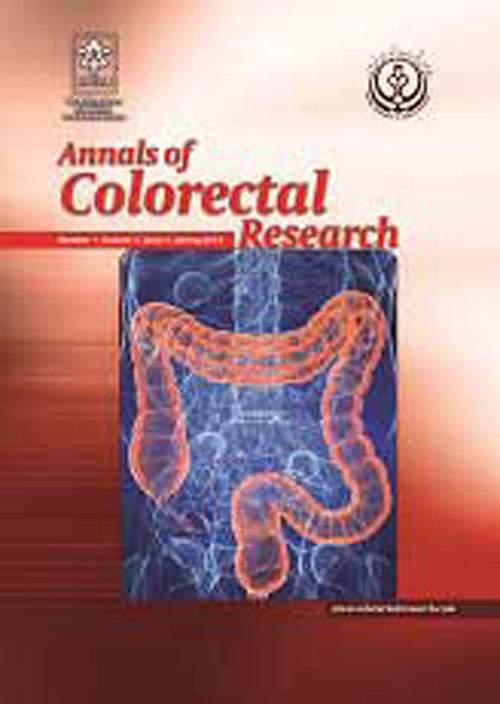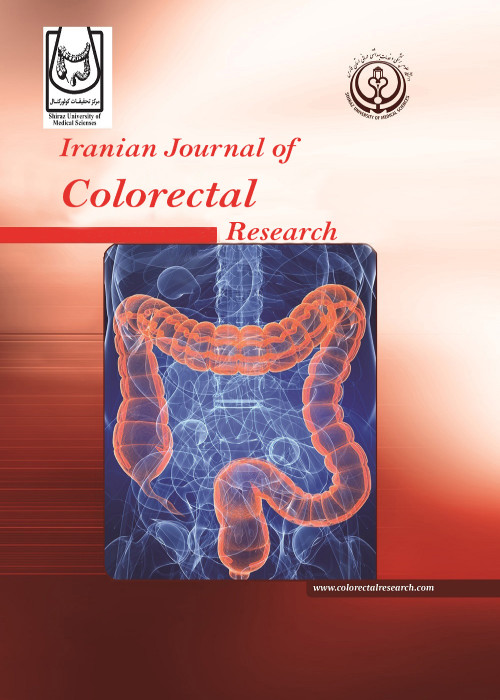فهرست مطالب

Iranian Journal of Colorectal Research
Volume:9 Issue: 3, Sep 2021
- تاریخ انتشار: 1400/07/19
- تعداد عناوین: 8
-
-
Pages 87-89
Colorectal Carcinoma is among the common types of cancer that affect people in the western countries, and the incidence approximated at 1.36 million cases globally in 2012 .Right hemicolectomy for the right-side colonic cancer is a procedure that is commonly conducted . Right hemicolectomy for the right-side colonic cancer is a procedure that is commonly conducted. In the current world, most states perform laparoscopic-assisted right hemicolectomy using the extracorporeal anastomotic method as the ordinary method. But, irrespective of the inception of laparoscopic surgery and advanced recovery techniques for colorectal surgery, the rate of morbidity remains considerable. Contemporary developments within invasive approaches have introduced intracorporeal anastomosis. Potentially, the danger associated with mesenteric twisting is minimal, as collated to the extracorporeal method. The study offered a useful comparison of the discharge rate between the two approaches for anastomosis in laparoscopic right hemicolectomy . The research hypothesizes that discharge that originates from anastomosis is less with intracorporeal anastomosis in laparoscopic right hemicolectomy.
Keywords: INTRACORPOREAL ANASTOMOSIS, EXTRACORPOREAL ANASTOMOSIS, RIGHT HEMICOLECTOMY, LEAKAGE RATE, Laparoscopic, ILEO-COLIC ANASTOMOSIS -
Pages 90-97BACKGROUND
Pathologic complete response (pCR) after neoadjuvant chemoradiotherapy (NCRT) has a prognostic value in locally advanced rectal cancer (LARC). This study aimed to evaluate the ability to predict pCR using inflammatory markers, valuable to select the most adequate treatment strategy.
METHODSPatients undergoing primary tumor resection after long-cycle NCRT at a single center (2012 to 2018) were retrospectively collected (n=130). Patient demographics, preoperative laboratory measurements, tumor characteristics, treatment strategy and postoperative anatomopathologic variables were collected. The association of factors to CPR was examined using binary logistic regression and odds ratio (OR) (95% confidence interval) and the discriminative capacity with ROC curve.
RESULTSOut of 130 patients 42 pCRs occurred, a 32.3% of the sample. Variables identified as useful to predict pCR were total neutrophil count (
CONCLUSIONSThe absolute neutrophil count better predicts pCR than the rest of inflammatory indexes in selected patients with LARC who underwent long-cycle NCRT. The association of a neutrophil count less than 6400 cells/mm3, absence of diabetes and intravenous 5-FU NCRT strategy showed a relevant increase of the pCR.
Keywords: Pathologic complete response, Neoadjuvant chemoradiotherapy, inflammatory indexes, Neutrophil, Rectal Cancer, tumor regression -
Pages 98-102
Introduction Ileocolic anastomoses can be made using a mechanical stapler device or by hand-sewn. A lot of studies, meta-analysis and Cochrane, discuss the safety of the two techniques. The aim of this study is to compare 2 different mechanical devices and charges: Echelon Flex with white charge (2.6 mm) versus EndoGIA with blue charge (3.5 mm) in isoperistaltic side-to-side ileocolic anastomosis after right hemicolectomy for cancer against similar surgical technique and post-operative management. Methods We made a retrospective analysis of all right hemicolectomies for malignancies performed between 1 January 2014 and 31 December 2019 in our department, comparing the mechanical device and the stapler charge used for the ileocolic isoperistaltic anastomosis. Results 151 patients underwent right hemicolectomy for cancer. In 101 cases the device used to perform ileocolic side-to-side isoperistaltic anastomosis was Echelon Flex with white charge (2.6 mm) and in 50 the device used was EndoGIA with blue charge (3.5 mm). There were no significant differences in the baseline. No differences in the complications rate according to Clavien-Dindo were found (p=0,727). In particular no differences were found in the rate of anastomotic leakage (p=0,851) or anastomotic bleeding (p=0,218). Median length of stay was 10 (IRQ 7-13) and 7 days (IRQ 6-11) respectively for the white and blue group (p=0,112). Conclusion Multiple papers discussed the best technique to perform the ileocolic anastomosis comparing manual and mechanical, iso and antiperistaltic, intra and extracorporeal ones. Nowadays in literature there are not yet comparative analysis about the stapler device and the type of charge used to do the ileocolic mechanical anastomosis.Mechanical anastomosis is safe and the use of the two indicated stapler with the described charges doesn’t show differences in terms of anastomotic leak or anastomotic bleeding in our experience. It is hoped that this study will stimulate further investigation in this field.
Keywords: ileocolic anastomosis, RIGHT HEMICOLECTOMY, Colon Cancer, Stapler, stapler charge -
Pages 103-108Background
Cancer stem cells (CSCs) have critical roles in tumor initiation, progression, metastasis, resistance to chemoradiotherapy, and recurrence in various cancers such as colon cancer. Therefore, extensive studies are required to understand the CSCs mechanism of action and design novel cancer therapies. Successful isolation and characterization of CSCs from tumor tissues or cancer cell lines provide the proper opportunity for these kinds of studies. This study aimed to isolate and characterize CSCs from HT29 colon cancer cell lines.
MethodsSphere formation assay was used to isolate CSCs from the HT29 cell line. The expression of four stemness genes, including LGR5, SOX2, c-Myc, and Oct4, was assessed by real-time PCR. The CSC markers, CD 44 and CD 24, were also evaluated and compared between the parental HT29 cell line and HT29-derived spheres by flow cytometry. Statistical analysis was performed using GraphPad Prism version 6.0 and the Mann-Whitney U test.
ResultsHT29-derived sphere cells were successfully formed in serum-free media. The proportion of CD 24 and CD 44-expressing cells and the expression of LGR5, SOX2, c-Myc, and Oct4 stemness genes were significantly higher in CSCs isolated from HT29 spheres compared with parental HT29 cells.
ConclusionSphere formation assay is a proper method for the isolation of CSCs from the HT29 cell line. The stemness markers LGR5, SOX2, c-Myc, Oct4,CD 44,andCD 24are suitable for the characterization of these cells.
Keywords: Cancer stem cell, Colon cancer, Stemness marker, Sphere formation -
Pages 109-113INTRODUCTION
Nowadays, the evolution of technology has made available instruments of very small caliber without affecting the surgical technique. Mini-laparoscopy (m-Lap) right hemicolectomy is an evolution of classic laparoscopy (c-Lap), consisting of three-port laparoscopic surgery using a 3-mm trocar.
METHODSA retrospective analysis of a prospectively constructed database was performed to assess the feasibility, safety, and efficacy of 3-mm instruments. We included patients undergoing a right hemicolectomy with c-Lap or m-Lap for cancer. Patients undergoing emergency, palliative, or open surgery were excluded. Primary outcomes were the rate of anastomotic leakage (AL), surgical site infection (iSSI), organ/space infection (OSI), and disease-free and overall survival. Secondary outcomes were the length of surgery and length of stay (LOS).
RESULTSBetween January 2015 and December 2020, seventy-five patients met the inclusion and exclusion criteria. Among them, 20 (26,67%) underwent m-Lap and 55 (73,33%) underwent c-Lap. The two groups had homogeneous baseline characteristics. There were no differences in AL (P=0.905), iSSI or OSI (P=0.831), disease-free survival (P=0.340), overall survival (P=0.351), length of surgery (P=0.742), or length of hospital stay (P=0.053).
CONCLUSIONA 3-mm trocar for right hemicolectomy is feasible, safe, and effective. It does not affect the quality of surgery or the short and long-term outcomes. We hope this study will stimulate further research on less invasive surgical instruments.
Keywords: Colorectal cancer, mini-Laparoscopy, reduced port, minimally invasive surgery, Right Hemicolectomy -
Pages 114-117
Enterobius vermicularis is one of the parasitic diseases involved in the etiology of acute appendicitis. Appendiceal diverticulitis is a rare clinical condition that often presents with the clinical manifestation of acute appendicitis. A 57-year-old woman was admitted to the emergency department with complaints of abdominal pain and loss of appetite. The patient, whose physical examination and imaging modalities were compatible with acute appendicitis, was hospitalized. The explorative laparotomy showed findings consistent with acute appendicitis and appendectomy was performed. No problem was seen during the postoperative follow-up of the patient and she was discharged with healing. The examination of the pathology specimen revealed the coexistence of appendiceal diverticulitis and Enterobius vermicularis. Although many cases of acute appendicitis due to Enterobius vermicularis infestation have been reported, the coexistence of appendiceal diverticulitis with Enterobius vermicularis has not been reported in the literature. This histopathological confirmation is vital regarding giving the necessary anthelmintic treatment to the case infected with Enterobius vermicularis and her relatives she is in contact with and preventing the spread of infection.
Keywords: Enterobius vermicularis, appendiceal diverticulitis, Diverticulitis, Appendicitis -
Pages 118-121Introduction
Inguinal hernias are common diseases in the population, and the prevalence of colorectal cancer has increased significantly in recent decades. However, the concomitant association of these two entities is rarely described in the literature. In most cases, due to the complex diagnosis, patients are treated in emergencies with obstruction or perforation. Nowadays, there is no established consensus on the best surgical approach when this association exists.
Case PresentationWe report a case of an 84-year-old patient admitted to the emergency room with a chronic inguinoscrotal hernia, with signs of intestinal obstruction, being diagnosed in the preoperative period by computed tomography, a neoplasm of the sigmoid colon incarcerated in the hernial sac. The patient underwent radical oncologic surgical treatment and inguinal herniorrhaphy through two access routes, with good postoperative evolution and outpatient follow-up after sixteen months.
ConclusionsThe association between CRC and inguinal hernia is unusual, but the surgeons should keep this possibility in mind because the treatment must be aimed to accomplish a safe oncologic outcome and as optimal as possible hernia repair.
Keywords: inguinal hérnia, sigmoid neoplasms, colectomy, herniorrhaphy -
Pages 122-123
Oral microbiota includes bacteria, fungi, protozoa, and viruses, which can translocate by the digestive tract and may favor the development of local benign or malignant pathology. Some researchers have studied the physiopathological mechanisms involving the role of oral microorganisms in intestinal diseases. Two major areas of these studies are colorectal cancer and COVID-19. Some of the intestinal manifestations of this pandemic may be associated with dysbiosis. Both sinergistic and antagonistic bacterial and fungal associations have been described in patients with colorectal cancer, characterizing dysbiosis. Oral microbes can cause opposite effects to the beneficial intestinal flora, eliciting DNA epithelial damage and apoptosis in the bowel as tumor triggering factors. Fusobacterium nucleatum and P. gingivalis were emphasized among the most often oral microorganisms found increased in evaluations of colorectal cancer. The recent advent of new biomarkers to diagnose colorectal tumor is also considered. The aim of these comments is to emphasize the usefulness of the more recent findings. Keywords: Colorectal cancer; Dysbiosis; Microbiota; Mycobiota
Keywords: Colorectal cancer, Dysbiosis, Microbiota, Mycobiota


